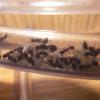Hi everyone. I'm new to ant keeping. Recently I've started making small plaster nests more for practice at the moment. However I'd like to start using either hydrostone or grout as they are stronger and more durable than PoP. But I have a couple of questions.
First, both hydrostone and grout contain portland cement. So how come these products are safe for ants when portland cement has a high alkalinity when freshly set? I mean, I used to make portland cement based caves etc for my fish tank. You can't just throw some freshly cast cement into an aquarium as it will increase the pH of the water. I'd put the objects into the toilet cistern for several weeks to reduce the alkalinity of them (the constant flushing works a treat, without wasting water). I haven't seen mention in nest tutorials of "aging" a new grout nest.
Second, reading the safety data sheet for Hydro-stone it seems to be simply a mix of ~95% plaster and ~5% portland cement. I haven't come across actual hydro-stone at the local hardware stores but I do have those two ingredients. So has anyone tried mixing their own by adding a small amount of portland cement to plaster?


















